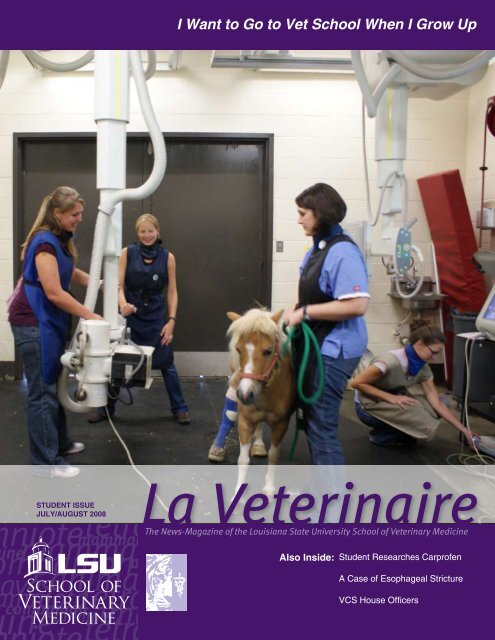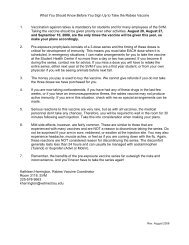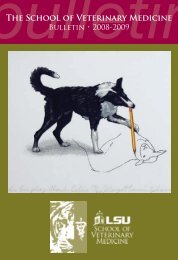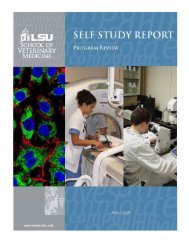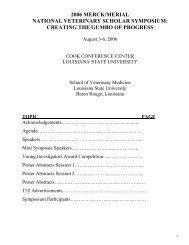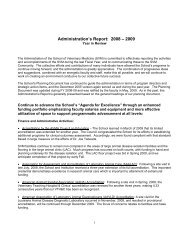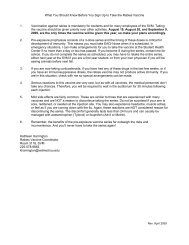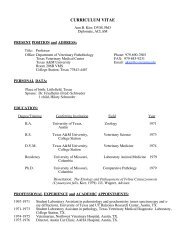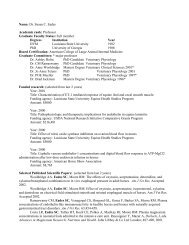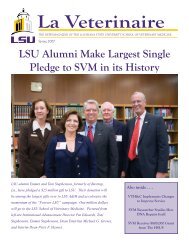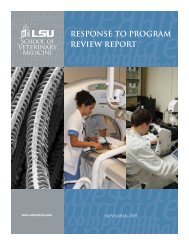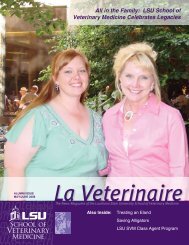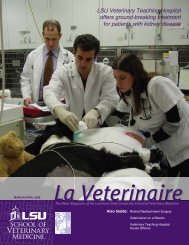I Want to Go to Vet School When - School of Veterinary Medicine ...
I Want to Go to Vet School When - School of Veterinary Medicine ...
I Want to Go to Vet School When - School of Veterinary Medicine ...
- No tags were found...
You also want an ePaper? Increase the reach of your titles
YUMPU automatically turns print PDFs into web optimized ePapers that Google loves.
I <strong>Want</strong> <strong>to</strong> <strong>Go</strong> <strong>to</strong> <strong>Vet</strong> <strong>School</strong><strong>When</strong> I Grow Up<strong>Vet</strong>erinary schools educate a wide variety <strong>of</strong> students. Thereare, <strong>of</strong> course, those students that attend <strong>to</strong> get a Doc<strong>to</strong>r <strong>of</strong><strong>Vet</strong>erinary <strong>Medicine</strong> degree, but veterinary schools also trainHouse Officers, those veterinarians who want specializedtraining and who work in the <strong>Vet</strong>erinary Teaching Hospital asinterns and residents. There are also residents in the fields <strong>of</strong>pathology and labora<strong>to</strong>ry animal medicine. In addition, thereare a number <strong>of</strong> students pursuing Master’s and doc<strong>to</strong>raldegrees that have very little, if anything, <strong>to</strong> do with theveterinary curriculum.Hilari French (Class <strong>of</strong> 2009)Hilari French was born <strong>to</strong> be a veterinarian. Her grandfatherDonald is a veterinarian, her father Dennis is a veterinarian,and her mother Nina is a veterinary technician. “This is whatI was born <strong>to</strong> do,” says Hilari. “There were no other optionsfor me.” Hilari is in her fourth year <strong>of</strong> veterinary school and isparticipating in the DVM/PhD program. It will take her at leas<strong>to</strong>ne more year after she receives her DVM before she will gether PhD.“I want <strong>to</strong> eventually go in<strong>to</strong> academia, so I knew that Ialso wanted <strong>to</strong> get my PhD,” said Hilari. Since LSU hasthe joint program, I can work on my DVM and PhD at thesame time.” Hilari participated in the Merck Merial SummerScholars Program during the summer after her first year <strong>of</strong>veterinary school. Her research project became the basisfor her PhD project. “<strong>When</strong> I was working on my SummerScholars project, I found that I really liked research,” saidHilari. “I decided that I wanted <strong>to</strong> stick with it.” Hilari’s PhDproject focuses on Chronic Wasting Disease in deer andhypothesizes that one <strong>of</strong> the causative agents <strong>of</strong> the diseaseis spiroplasm mirin.2
“After school, I’d like <strong>to</strong> work with undergraduate students whoare interested in veterinary science,” said Hilari. “I’d like <strong>to</strong>help students get in<strong>to</strong> veterinary school.” <strong>When</strong> asked whatadvice she would give those students right now, Hilari replied,“Train yourself <strong>to</strong> study during your first semester <strong>of</strong> college.Time management is very important. You have <strong>to</strong> give yourself plenty <strong>of</strong> time <strong>to</strong> study, but also leave free time so youcan be a real person.”David Schur (Class <strong>of</strong> 2010)David Schur is a non-traditional veterinary student; he was30 when he started veterinary school. “I had a biologicalbackground, and I was always good with animals, so one dayI said, ‘Maybe I can be a vet.’ It’s funny,” Dave recalls, “<strong>When</strong>I first called Claire Miceli in the Student Affairs <strong>of</strong>fice <strong>to</strong> askabout applying, she went over my transcripts and <strong>to</strong>ld me <strong>to</strong>start over.” Not wanting <strong>to</strong> start from scratch, David set aboutfulfilling his pre-requisites and working with veterinarians inthe New Orleans area. “As soon as I set <strong>of</strong>f down this path,wonderful things started happening for me. That’s how I knewI was doing the right thing.”ABOVE: Dr. Ashley Martin (LSU 2006) is currently a smallanimal medicine resident at the LSU SVM. Her clinicalinterests are infectious disease and nephrology.In addition <strong>to</strong> being a veterinary student, David is also thecurrent president <strong>of</strong> the Student Chapter <strong>of</strong> the American<strong>Vet</strong>erinary Medical Association (SCAVMA). “I served asparliamentarian in SCAVMA because I wanted <strong>to</strong> be involvedin the organization. After that, I just wanted <strong>to</strong> continue thegreat work we started under Mike Ratcliff [past president].As president, I want <strong>to</strong> improve the lives <strong>of</strong> the students, andthe image <strong>of</strong> the <strong>School</strong> on a national level. We reorganizedthe Aesculapian Ball so it’s debt-free and are trying <strong>to</strong> makeimprovements <strong>to</strong> the cafeteria. We also made a great effort <strong>to</strong>play host and welcome all <strong>of</strong> the out-<strong>of</strong>-state students at theAVMA Annual Conference. I want the students <strong>to</strong> know thattheir SCAVMA dues go <strong>to</strong>ward something positive for themand for the <strong>School</strong>.”After graduation, David is considering an internship inradiology. “Dr. [Lorrie] Gaschen has been a men<strong>to</strong>r for me,”said Dave. She was my advisor for the Merck-Merial SummerScholars Program last year, and she hired me as a summerstudent worker this year.” For anyone considering a careerin veterinary medicine, Dave advises, “People can get lostin the process and think that one class or one exam meanseverything; remember that there’s a lot more <strong>to</strong> life than vetschool, and you should enjoy it.”ABOVE: David Schur (Class <strong>of</strong> 2010) is working with Dr.Lorrie Gaschen, associate pr<strong>of</strong>essor <strong>of</strong> veterinary radiology,during the summer.ABOVE LEFT: Fourth-year veterinary student Hilari French(left) prepares <strong>to</strong> take a radiograph <strong>of</strong> a miniature horse withassistance from Meghan Johnson Respess (center), EmelieMcLellen (holding the horse), and Patricia Schuster (kneeling).All <strong>of</strong> these students are members <strong>of</strong> the Class <strong>of</strong> 2009.3
Jeff Cardinale, PhD StudentJeff Cardinale is working on his PhD in the Department <strong>of</strong>Comparative Biomedical Sciences at the LSU SVM. He isworking in the labora<strong>to</strong>ry <strong>of</strong> Dr. Joseph Francis, associatepr<strong>of</strong>essor, investigating the role <strong>of</strong> his<strong>to</strong>ne acetylasesand deacetylases in modulating TNF expression in theprogression <strong>of</strong> heart failure and hypertension. Cardinalereceived his BS in Animal, Dairy, Poultry Science: Scienceand Technology (along with a minor in Biology and Spanish)from LSU in May 2006.“Having had the opportunity <strong>to</strong> work here as anundergraduate around some great faculty (specifically Drs.Susan Eades, Ashley S<strong>to</strong>kes, and Rustin Moore), I came<strong>to</strong> really appreciate the level <strong>of</strong> research they employed intheir labs and in the field,” said Cardinale. “Their enthusiasm<strong>to</strong>wards their research was strongly palpable and fosteredwithin me a desire <strong>to</strong> pursue that same feeling <strong>of</strong> discovery.Much <strong>of</strong> their research centered on inflammation’s role in thecontinuance <strong>of</strong> pathophysiological disorders, a subject thatreally interested me. Likewise, Dr. Francis’s lab intrigued medue <strong>to</strong> his investigation <strong>of</strong> these same processes regardingthe cardiovascular system, a system whose regula<strong>to</strong>ryabilities have also always interested me, making this lab avery nice fit.”ABOVE: Jeff Cardinale is working on his PhD in theDepartment <strong>of</strong> Comparative Biomedical Sciences at the LSUSVM. He is working in the labora<strong>to</strong>ry <strong>of</strong> Dr. Joseph Francis,associate pr<strong>of</strong>essor, investigating the role <strong>of</strong> his<strong>to</strong>ne acetylasesand deacetylases in modulating TNF expression in theprogression <strong>of</strong> heart failure and hypertension.Cardinale feels a strong connection with the SVM’s EquineHealth Studies Program. “I will always be indebted <strong>to</strong> theEHSP, from <strong>to</strong>p <strong>to</strong> bot<strong>to</strong>m (Catherine Koch, Michael Keowen,Drs. Britta Leise and Sara Lyle--just <strong>to</strong> name a few),” addedCardinale. He was able <strong>to</strong> work on several laminitis projectsand got a hands-on feel for all aspects <strong>of</strong> the field, bothveterinary and research.“I would like <strong>to</strong> continue <strong>to</strong> conduct research in cardiovascularpathophysiology and, hopefully, in time, aid in new therapeuticapproaches against heart failure and hypertension,” saidCardinale.<strong>School</strong>s <strong>of</strong> veterinary medicine <strong>of</strong>fer a wide array <strong>of</strong>educational and career opportunities. For more informationabout the LSU <strong>School</strong> <strong>of</strong> <strong>Vet</strong>erinary <strong>Medicine</strong> and itscurriculum and programs, go <strong>to</strong> www.vetmed.lsu.edu.ABOVE: Husband and wife veterinarians, Drs. Brit<strong>to</strong>n (left)and Brooke Grasperge are both alumni <strong>of</strong> the LSU SVM.Brit<strong>to</strong>n received his DVM in 2006, and Brooke received herDVM in 2007. Brit<strong>to</strong>n is currently a pathology resident in theDepartment <strong>of</strong> Pathobiological Sciences, and Brooke is alabora<strong>to</strong>ry animal resident in the Department <strong>of</strong> ComparativeBiomedical Sciences. They will complete their respectiveresidencies in 2009.5
the mi<strong>to</strong>chondria. Tempol is a superoxide-scavenger that quenches reactiveoxygen species; thus, it is thought that pre-treatment <strong>of</strong> cells with this chemicalcould protect them somewhat from the damaging effects <strong>of</strong> Carpr<strong>of</strong>en.Julia has isolated the mi<strong>to</strong>chondria from the liver cells and performedseveral different assays that appear <strong>to</strong> confirm that the mechanism bywhich Carpr<strong>of</strong>en causes damage <strong>to</strong> cells that line the gastrointestinal tractis the same as that <strong>of</strong> other NSAIDs, and that tempol does, indeed, <strong>of</strong>fersome protective effects. She performed a swelling assay using a multi-scanspectropho<strong>to</strong>meter <strong>to</strong> measure the integrity <strong>of</strong> mi<strong>to</strong>chondrial membranes, andthis indicated that Carpr<strong>of</strong>en does increase the porosity <strong>of</strong> the membranesin the same manner as other NSAIDs. Most impressive, however, werethe electronmicrographs <strong>of</strong> mi<strong>to</strong>chondria from cells exposed <strong>to</strong> Carpr<strong>of</strong>encompared <strong>to</strong> those <strong>of</strong> mi<strong>to</strong>chondria in cells that had been pre-treated withtempol. These pho<strong>to</strong>graphs indicate that, under controlled labora<strong>to</strong>ryconditions, tempol can reduce the cellular damage caused by Carpr<strong>of</strong>en.Julia’s research may lead <strong>to</strong> future studies involving in vivo trials. Sheenvisions an investigation in which tempol will be administered <strong>to</strong> dogs prior<strong>to</strong> dosing with Carpr<strong>of</strong>en in order <strong>to</strong> evaluate whether the protective effec<strong>to</strong>bserved in her research this summer will translate <strong>to</strong> a procedure that canone day be used in clinical practice.Merck/Merial SummerScholars ProgramFor the seventh consecutive year,LSU SVM is conducting its SummerScholars Program. Funded by eightMerck-Merial Animal Health Grants,this competitive research effort isdesigned <strong>to</strong> further students’ learningand experiences beyond the requiredclassroom and clinical training. Theprogram encourages innovativestudies in human and animal diseasesand lends further understanding<strong>to</strong> veterinary careers in biomedicalresearch.For the fifth consecutive year, theNational Institutes <strong>of</strong> Health (NIH)also provided grants <strong>to</strong> LSU SVMstudents for summer study, makingthe LSU SVM one <strong>of</strong> only eightveterinary schools in the country withsummer grant programs funded byboth Merck-Merial and the NIH. Inaddition, for the second straight year,a student from the LSU SVM receivedthe single fellowship <strong>of</strong>fered each yearby the Comparative GastroenterologySociety.ABOVE: Mi<strong>to</strong>chondria after the pretreatment with Tempol and then being exposed<strong>to</strong> Carpr<strong>of</strong>en.The Summer Scholars Programpositions are open <strong>to</strong> first-and secondyearveterinary students, who, underthe guidance <strong>of</strong> a faculty men<strong>to</strong>r,submit research proposals. Successfulapplicants receive a $5,000 stipend fortheir work and will travel <strong>to</strong> the 2008Merck-Merial Symposium, held thisyear at Michigan State University July31-August 3. Students from all theparticipating veterinary schools in theUnited States and Canada will gather<strong>to</strong> present the results <strong>of</strong> their research.ABOVE LEFT: Julia Coutin (Class <strong>of</strong> 2010) is one <strong>of</strong> 16 students participating inthe Merck/Merial Summer Scholars Program. Her project is entitled, “The <strong>to</strong>picaleffect <strong>of</strong> Carpr<strong>of</strong>en on the function <strong>of</strong> canine hepatic mi<strong>to</strong>chondria.”7
Clinical Case StudyA Case <strong>of</strong> Esophageal Stricture in a10-Year-Old Boxer“Sonic” is a 10-year-old male boxer who presented oneSunday afternoon with a short his<strong>to</strong>ry <strong>of</strong> acute retchingand coughing. Dr. Bettina Mayer-Roenne, now a secondyearresident in Small Animal Internal <strong>Medicine</strong>, was onemergency duty that day and examined him.On examination, Sonic seemed well, except for occasionalretching. After discussion, it was decided <strong>to</strong> radiograph hischest. The radiograph showed a large mass between hisheart and s<strong>to</strong>mach, indicating either a foreign body or a massin the esophagus.An immediate endoscopy was recommended, and Sonicwas given a full pre-operative workup. The results <strong>of</strong> alltests were within normal values, so he was anesthetizedand endoscopied. The operating team discovered a largepiece <strong>of</strong> bone, <strong>to</strong> which dog food was adhered, lodged in theesophagus just before the opening <strong>to</strong> the s<strong>to</strong>mach. The bonewas removed, but it was noted that there was considerabledamage <strong>to</strong> the esophageal mucosa.Sonic stayed the night at the LSU SVM, where he recoveredwell from the procedure. He was discharged home, eating and8
drinking normally. Within about a week, however, he beganregurgitating after feeding, so he was placed on a liquid dietfor two weeks at home. His condition did not improve, so hewas brought back <strong>to</strong> the Small Animal Clinic for a secondendoscopy.Dr. Mayer-Roenne and Cristin McCamish, a fourth-yearveterinary student, performed another endoscopy. Theyfound that Sonic had developed a severe esophagitis andthat scar tissue had produced a circular stricture that reducedthe lumen <strong>to</strong> about 2 mm. The opening was so small thatthey could not pass the endoscope in<strong>to</strong> the s<strong>to</strong>mach. Dr.Mayer-Roenne dilated the stricture using a small balloonand inflated it <strong>to</strong> gently stretch the esophageal lumen withoutcausing more damage; using successively larger balloons,she and Cristin were able <strong>to</strong> enlarge the opening <strong>to</strong> about 14mm. Sonic again recovered well and went home the sameday, able <strong>to</strong> drink normally and eat a liquid diet. He wasprescribed a course <strong>of</strong> sucralfate, <strong>to</strong> coat the esophagus, andomeprazole, <strong>to</strong> reduce gastric acidity, in order <strong>to</strong> encouragehealing <strong>of</strong> the esophagitis.At a scheduled 10-day recheck, Dr. Mayer-Roennediscovered that the lumen had a slight restricture—down <strong>to</strong>10 mm—which was not unexpected, given the severity <strong>of</strong>the initial condition. However, the esophagitis had resolved,indicating that the medications had worked as anticipated.This time, using larger balloons, they were able <strong>to</strong> open theesophagus <strong>to</strong> about 20 mm.Sonic returned one week later for his last endoscopy andwas found <strong>to</strong> still be doing well. Dr. Mayer-Roenne againballooned his esophagus <strong>to</strong> 20 mm as a precaution, but didnot anticipate any further significant restricturing.Sonic was <strong>to</strong> remain on the medications for three moreweeks, but no further procedures are anticipated. Hisprognosis is good, and he is expected <strong>to</strong> be able <strong>to</strong> eatcanned or blenderized food without problems from now on.His days <strong>of</strong> dining on bones and rawhide chews, however, arebehind him.LEFT: The radiograph showeda large mass between his heartand s<strong>to</strong>mach, indicating eithera foreign body or a mass in theesophagus.ABOVE LEFT: Dr. BettinaMayer-Roenne, small animalmedicine resident, and CristinMcCamish, a fourth-yearveterinary student, with Sonic.9
Dr. James Rundell (left), president <strong>of</strong> the Louisiana <strong>Vet</strong>erinary MedicalAssociation, bes<strong>to</strong>ws the LVMA Outstanding Student Awards on (from left<strong>to</strong> right) Julie Schexnider (Class <strong>of</strong> 2008), Holly Brown (Class <strong>of</strong> 2010), andMarc Bordelon (Class <strong>of</strong> 2009) at the LSU SVM Awards & Honors Banquetheld on May 2. Over $130,000 was distributed <strong>to</strong> students at the banquet inthe form <strong>of</strong> wards and scholarships.Dr. David Senior, associate dean for advancement andstrategic initiatives, congratulates Jana Doege (Class <strong>of</strong> 2008)at the Awards & Honors Banquet upon her receipt <strong>of</strong> theArkansas <strong>Vet</strong>erinary Medical Foundation Jack R. Redman andElizabeth G. Redman Senior Award. Not pictured is the otheraward recipient Rachel Warner (Class <strong>of</strong> 2008).Over 130 alumni, faculty, staff, students and friends <strong>of</strong> the LSU SVMattended the reception at the Tropical Isle on Bourbon Street in NewOrleans, La., as part <strong>of</strong> the American <strong>Vet</strong>erinary Medical AssociationAnnual Conference.LSU SVM alumni (from left <strong>to</strong> right) Drs. Amy Porter (LSU 2007),Amy Nunemacher (LSU 2007), Erica Wallace (LSU 2006), and AlissaWhitney (LSU 2006) attended the alumni and friends reception at theTropical Isle.If you have pho<strong>to</strong>s <strong>of</strong> your time at the LSU SVM and would like <strong>to</strong> share them, please contact Ginger Guttner, coordina<strong>to</strong>r <strong>of</strong> publicrelations, at 225-578-9922 or gguttner@vetmed.lsu.edu.15
House OfficersResidents and Interns in the Departmen<strong>to</strong>f <strong>Vet</strong>erinary Clinical SciencesDr. Petrisor Baia,intern, Equine <strong>Medicine</strong> and Surgery(7/14/2008-7/10/2009), received hisDr.med.vet from Banat’s University <strong>of</strong>Agricultural Science and <strong>Vet</strong>erinary<strong>Medicine</strong> in Timisoara, Romania, in2004.Dr. Re<strong>to</strong>Barmettler, resident,Companion Animal <strong>Medicine</strong> (7/1/2008-6/30/2009), received his DVM from<strong>Vet</strong>suisse-Faculty <strong>of</strong> Zurich (Switzerland)in 2003. He then completed a smallanimal internship at the <strong>Vet</strong>suisse-Faculty in Bern in 2007.From 2004-2006, Dr. Barmettler did a doc<strong>to</strong>ral thesis at theuniversity <strong>of</strong> Bern in combination with anesthesia service inthe Department <strong>of</strong> Radiology for all MRI patients in Bern.He then started his first year <strong>of</strong> the residency in Bern and iscurrently in his second year.Dr. HuguesBeaufrere, resident,Zoological <strong>Medicine</strong> (7/14/2008-7/15/2011), received his DVM from theNational <strong>Vet</strong>erinary <strong>School</strong> <strong>of</strong> Lyon,France, in 2006. He then completed asmall animal and exotics medicine internship at the Brasseur<strong>Vet</strong>erinary Clinic in Manage, Belgium, and an avian andexotics medicine internship at the University <strong>of</strong> Guelph inOntario, Canada. Dr. Beaufrere’s clinical interests are inavian medicine, and he was a falconer for three years prior <strong>to</strong>starting his two internships.Dr. Justin Card,intern, Companion Animal <strong>Medicine</strong> andSurgery(6/16/2008-6/30/2009), receivedhis DVM from Purdue University in 2008.Dr. IsabelleCattin, resident, Small Animal<strong>Medicine</strong> (7/16/2007-7/15/2009), receivedher DVM from the University <strong>of</strong> Bern inSwitzerland in 2001. She completed asmall animal internship at the University<strong>of</strong> Vienna in Austria in 2006, and herclinical interests are hema<strong>to</strong>logy, immunology and neurology.Dr. Kemba Clapp,intern, Radiology (7/14/2008-6/30/2009),received her DVM from TuskegeeUniversity in 2007. She then completeda small animal medicine and surgeryinternship at Fifth Avenue <strong>Vet</strong>erinarySpecialists in New York, N.Y.Dr. Myra Durham,intern, Equine <strong>Medicine</strong> and Surgery(7/1/2008-6/30/2009), received her DVMfrom North Carolina State University in2007. She then completed a large animalmedicine and surgery internship at theUniversity <strong>of</strong> Georgia.Dr. Alina Evans,intern, Companion Animal <strong>Medicine</strong> andSurgery (6/16/2008-6/30/2009), receivedher DVM in 2008 and her MPH in 2007,both from the University <strong>of</strong> Minnesota.Her clinical interests are in conservationmedicine and ophthalmology.Dr. DionneFerguson, resident,Companion Animal <strong>Medicine</strong> (7/14/2008-7/14/2011), received her DVM fromLouisiana State University in 2007. Shethen completed a small animal internshipat the Louisiana <strong>Vet</strong>erinary ReferralCenter in Mandeville, La. Her clinical interests are endocrineand infectious disease.16
Dr. TimmGudehus, resident, EquineSurgery (7/16/2007-7/15/2010), graduatedfrom the Ludwig Maximilians University inMunich, Germany, in December 2003 inthe department for experimental surgeryfor human implan<strong>to</strong>logy. After completion<strong>of</strong> this internship at a clinic located at the Munich racetrack,he received his Dr.med.vet at his alma mater. He completeda second internship/fellowship in equine orthopedics andimaging/sports medicine at California Equine Orthopedicsin San Marcos, Calif., before coming <strong>to</strong> LSU for his equinesurgery residency. Dr. Gudehus’ clinical interest is equinesurgery, and his personal focus is equine orthopedics.Dr. EricaHartmann, fellow,Companion Animal Surgery (7/14/2008-7/13/2009), received her DVM fromKansas State University in 2006. Shethen completed a rotating small animalmedicine and surgery internship at the University <strong>of</strong> Illinoisand a surgical internship at the Dallas <strong>Vet</strong>erinary SurgicalCenter.Dr. GwendolynJankowski, intern, Zoological<strong>Medicine</strong> (6/20/2008-6/30/2009), receivedher DVM from Oklahoma State Universityin 2008.Dr. Andrew J.Lewis, resident, Equine Surgery(7/17/2006-7/17/2009), received hisDVM from LSU in 2005. He completedan internship in Large Animal <strong>Medicine</strong>and Surgery at the University <strong>of</strong> GeorgiaCollege <strong>of</strong> <strong>Vet</strong>erinary <strong>Medicine</strong> in2006. Dr. Lewis’ clinical interests areorthopedics, upper respira<strong>to</strong>ry surgery, and abdominalsurgery.Dr. Dena Loda<strong>to</strong>,intern, Companion Animal <strong>Medicine</strong> andSurgery(6/16/2008-6/30/2009), receivedher DVM from Mississippi State Universityin 2008.Dr. Ge<strong>of</strong>f Hennig,resident, Companion Animal Surgery(7/17/2006-7/17/2009), received hisDVM from Ross University in 2005. Hecompleted an internship at the University<strong>of</strong> Georgia in 2006, and his clinical area <strong>of</strong>interest is orthopedics.Dr. Jennifer Huck,resident, Companion Animal Surgery(7/14/2008-7/14/2011), received herDVM from The Ohio State Universityin 2006. She then completed a smallanimal medicine and surgical rotatinginternship at Michigan State Universityand was a post-doc<strong>to</strong>ral research fellow at the University <strong>of</strong>Pennsylvania.Labora<strong>to</strong>ry Animal ResidentsDr. Mark Bates (7/’1/2007-6/30/2009)Dr. Maggie Gilbert (7/’1/2007-6/30/2009)Dr. Brooke Fahrig Grasperge (7/1/2007-6/30/2009)Pathology ResidentsDr. Brit<strong>to</strong>n Grasperge (7/1/2006-2009)Dr. Sanjeev Gumber (5/1/2008-2011)Dr. Aradhana Gupta 8/2008 (Tentatively)Dr. Scott Reed (7/1/2006-2009)Dr. Eric Snook (8/1/2006-2009)17
VCS House Officers continuedDr. KerithLuchins, intern, CompanionAnimal <strong>Medicine</strong> and Surgery (6/16/2008-6/30/2009), received her DVM from theUniversity <strong>of</strong> Illinois in 2008.Dr. AshleyMartin, resident, SmallAnimal <strong>Medicine</strong> (7/16/2007-7/16/2009),received her DVM from LSU in 2006.She completed an internship at TuftsUniversity, and her clinical interests areinfectious disease and nephrology.Dr. BettinaMayer-Roenne,resident, Small Animal <strong>Medicine</strong>(7/16/2007-7/16/2009), received herDVM from the University <strong>of</strong> <strong>Vet</strong>erinary<strong>Medicine</strong> in Vienna, Austria, in 2002.She completed an internship at CornellUniversity in 2004, and then worked as an emergencyclinician and visiting instruc<strong>to</strong>r at Cornell in 2006. Herclinical interests are internal medicine (endocrinology andnephrology), emergency medicine and critical care, andneurology.Dr. Kelly Rachal,resident, Theriogenology (7/14/2008-7/15/2011), received her DVM fromTuskegee University in 2007.Dr. WilliamRatterree, intern, CompanionAnimal <strong>Medicine</strong> and Surgery (6/16/2008-6/30/2009), received his DVM from theUniversity <strong>of</strong> Georgia in 2008.Dr. CarleySaelinger, intern, Cardiology(7/7/2008-7/3/2009), received her VMDfrom the University <strong>of</strong> Pennsylvania in2007. She then completed a rotatinginternship in small animal medicine andsurgery at the University <strong>of</strong> Florida. Dr. Saelinger’s clinicalinterests include congenital cardiac disease in dogs andtreatment <strong>of</strong> arrhythmias.Dr. RodneySchnellbacher,intern, Anesthesia (6/16/2008-6/30/2009),received his DVM from the University <strong>of</strong>Missouri in 2008.Dr. LauraSickafoose, resident,Derma<strong>to</strong>logy (7/14/2008-7/16/2010),received her DVM from the University<strong>of</strong> California, Davis in 2007. She thencompleted a general rotating internship atSan Francisco <strong>Vet</strong>erinary Specialists.Dr. Lynne A. Snow,resident, Companion Animal Surgery(7/16/2007-7/16/2010), received her DVMfrom the University <strong>of</strong> Illinois in 2004.She completed an internship with the<strong>Vet</strong>erinary Medical and Surgical Groupin Ventura, Calif., as well as a surgicalinternship with the Animal SpecialtyGroup in Los Angeles, Calif. Dr. Snow’sresearch interest is cranial cruciate ligament rupture.Dr. Nora Springer,intern, Companion Animal <strong>Medicine</strong> andSurgery(6/16/2008-6/30/2009), receivedher DVM from Kansas State University in2008.Dr. SimonStaempfli, resident, EquinePractice (7/23/2007-7/17/2009), receivedhis DVM from <strong>Vet</strong>suisse Faculty,University <strong>of</strong> Bern, Switzerland, inDecember 2003. He worked in privatepractice in Switzerland for two years,and he completed an internship inLarge Animal Surgery and <strong>Medicine</strong> at Ontario <strong>Vet</strong>erinaryCollege, University <strong>of</strong> Guelph, Canada, as well as a18
esidency in Equine Practice at LSU. Dr. Staempfli’sclinical interests are equine surgery, medicine andtheriogenology.project involves the effects <strong>of</strong> clenbuterol on skeletal musclecomposition, cardiac function, and biochemical markers <strong>of</strong>muscle injury in exercising horses.Dr. JessicaThompson, resident,Equine <strong>Medicine</strong> (7/17/2006-7/17/2009),received her DVM in 2005 from TexasA&M University. She completed arotating medicine and surgery internshipat the Equine Medical Center <strong>of</strong> Ocalain Florida, in 2006. Her clinical interests are equineinternal medicine, especially neona<strong>to</strong>logy, neurology,emergency/critical care, ultrasonography. Her MSDr. RebekahWestermeyer, resident,Derma<strong>to</strong>logy (7/14/2008-7/16/2010),received her DVM from Iowa StateUniversity in 2006. In 1999, she receiveda MS in music from the University <strong>of</strong>Nebraska-Lincoln. Prior <strong>to</strong> coming <strong>to</strong>LSU, Dr. Westermeyer was an associate/relief veterinarian fortwo <strong>of</strong> four Caring Hands Animal Hospitals in Centreville andBris<strong>to</strong>w, Va.Class <strong>of</strong> 2008 StatisticsEighty-three veterinary students received their DVMdegrees from the LSU <strong>School</strong> <strong>of</strong> <strong>Vet</strong>erinary <strong>Medicine</strong>on May 12. Fifty-eight members <strong>of</strong> the Class <strong>of</strong>2008 participated in an American <strong>Vet</strong>erinary MedicalAssociation survey for new graduates. According <strong>to</strong> thesurvey, 36 graduates are pursuing careers in veterinarypractices in the following states (the other 22 are goingin<strong>to</strong> advanced study):State Average Salary NumberArkansas $67,900 5California $85,000 1Florida $80,000 1Louisiana $72,929 14Michigan $85,000 1Nevada $84,900 7New York $50,000 1Texas $71,350 4Utah $87,000 1Virginia $85,000 1Of these 36 graduates, 30 are going in<strong>to</strong> small animalpractice, four are going in<strong>to</strong> a mixed practice, and twoare going in<strong>to</strong> a large animal or equine practice.The average starting salary overall for the graduatesgoing in<strong>to</strong> practice is $75,339. The average startingsalary for graduates staying in Louisiana is $72,929, andthe average salary for graduates pursuing careers out-<strong>of</strong>stateis $76,873.The average debt for new graduates is $120,478.The debt for the Class <strong>of</strong> 2008 ranges from $8,500 <strong>to</strong>$335,000. Seventy-three out <strong>of</strong> the 83 graduates hassome debt.Class <strong>of</strong> 2012 StatisticsTotal number <strong>of</strong> applicants 713Total number admitted 84**This does not include two students who were readmittedfrom previous classes (one Louisiana residentwas readmitted and one Puer<strong>to</strong> Rico resident wasreadmitted).Breakdown by applicant typeLouisiana residents 55Arkansas residents 9Puer<strong>to</strong> Rico residents 2Out-<strong>of</strong>-State residents 18DemographicsFemale 64 (76.2%)Male 20 (23.8%)Average age 24.2Average GPA & GRERequired course GPA 3.76Last 45 hours GPA 3.79GRE score 113919
Equine Health Studies ProgramLimited Equine Lay DentistryShort Course Held at LSUThe 2008 edition <strong>of</strong> the Limited Equine Dentistry Short Coursewas held June 18-21, 2008, at the LSU <strong>School</strong> <strong>of</strong> <strong>Vet</strong>erinary<strong>Medicine</strong>. The course was designed <strong>to</strong> fulfill the requirements<strong>of</strong> the Louisiana State Board <strong>of</strong> <strong>Vet</strong>erinary Medical Examinersfor the practices <strong>of</strong> limited equine dentistry by the nonveterinarian.The course, which <strong>of</strong>fered practical hands-on equine dentistryknowledge <strong>to</strong> five participants, included a review <strong>of</strong> equinedental ana<strong>to</strong>my, aging, common dental abnormalities inhorses, dental equipment and floating techniques andapproximately 10 hours <strong>of</strong> actual floating on 29 live horses.Lectures were provided by the faculty <strong>of</strong> the <strong>School</strong> <strong>of</strong><strong>Vet</strong>erinary <strong>Medicine</strong>, and labora<strong>to</strong>ry teaching was carried outby EHSP faculty, including Dr. Charles McCauley, Dr. DanBurba and technician John Ladner; and Mr. Frank Albert <strong>of</strong>Albert’s Equine Dental Supply. Albert’s Dental Supply alsoprovided all <strong>of</strong> the necessary hand equipment for the course.At the conclusion <strong>of</strong> the course, participants were required<strong>to</strong> complete an unassisted dental examination and a routinedental float on a horse. Participants also had <strong>to</strong> take andpass a written examination in order <strong>to</strong> receive a certificate<strong>of</strong> completion and have their names submitted <strong>to</strong> the stateboard <strong>to</strong> legally practice limited equine dentistry in the state<strong>of</strong> Louisiana. The course is limited <strong>to</strong> a maximum <strong>of</strong> eightparticipants, and all five <strong>of</strong> the 2008 participants successfullycompleted the requirements for licensing.For questions or information on next year’s dental course,please contact the Equine Health Studies Program at LSU at225-578-9500.20
Alumni Pr<strong>of</strong>ileDr. Catherine White (LSU 1993, right), then president <strong>of</strong> the Louisiana <strong>Vet</strong>erinary MedicalAssociation, and Dr. Craig Guidry (LSU 1990, left), then LVMA president-elect, bes<strong>to</strong>wthe Louisiana <strong>Vet</strong>erinary Medical Association Outstanding Student Awards in May 2006<strong>to</strong> (from left <strong>to</strong> right) Wesley Lee (LSU 2008); Brooke Fahrig (LSU 2007); Ashley Martin(LSU 2006).1993 Alumnus Dr. Catherine WhiteWhat made you want <strong>to</strong> be a veterinarian?In grade school, I really enjoyed science and math. A sixthgrade teacher encouraged me <strong>to</strong> think about veterinarymedicine as a career. My grandfather continued <strong>to</strong> cultivatemy interests by allowing me <strong>to</strong> help on his farm, working witha variety <strong>of</strong> animals. That year was a particularly bad lambingyear, with several dys<strong>to</strong>cias. My grandfather’s hands were<strong>to</strong>o large <strong>to</strong> reposition the lambs, so he talked me through theprocedure <strong>of</strong> “pulling” a lamb. I was HOOKED on my goal <strong>to</strong>be a veterinarian!What was LSU SVM like when you attended?A large family with 64 brothers and sisters.How did the LSU SVM prepare you for your careerin veterinary medicine?LSU SVM certainly taught me a very large amount aboutveterinary medicine. You can, <strong>of</strong> course, never be taughteverything about your career by attending college.What does the LSU SVM mean <strong>to</strong> you?LSU SVM means a lot <strong>to</strong> me because that is where a majorgoal in my life was achieved.What are some <strong>of</strong> your most memorable momentsfrom LSU?Any LSU student’s answer would have <strong>to</strong> be “the footballgames!!” Watching the Mike the tiger cub running the halls<strong>of</strong> the vet school was a memorable moment. There has <strong>to</strong>be a memory <strong>of</strong> some sort about gross ana<strong>to</strong>my lab in everyvet school student’s mind! Farm animal and equine rotationswere very memorable.Bio Bullets• I’ve been married for 18 years with a son (age 14) anddaughter (age 11).• I was very fortunate <strong>to</strong> be able <strong>to</strong> move back <strong>to</strong> myhome<strong>to</strong>wn after graduation. I am a solo practitioner in smallanimal medicine.• My undergraduate work was at LSU Ba<strong>to</strong>n Rouge inDairy Production.• I am a member <strong>of</strong> the Louisiana <strong>Vet</strong>erinary MedicalAssociation and the American <strong>Vet</strong>erinary Medical Association,and I am very involved in my church and children’s school. Iam a present member and past president <strong>of</strong> the DeRidderLions Club, and I’m a current member and prior boardmember <strong>of</strong> the Greater Beauregard Chamber <strong>of</strong> Commerce.21
Alumni Pr<strong>of</strong>ileAdvanced Studies AlumnusDr. Bernhard KaltenboeckWhat made you want <strong>to</strong> be a research scientist?Since early childhood I was interested in finding out how <strong>to</strong>ysor machines worked. I <strong>to</strong>ok apart many <strong>to</strong>ys, and sometimeswas even able <strong>to</strong> re-assemble them. Later, my interest mademe study Chemical Engineering, but I s<strong>to</strong>pped when I realizedthat University system in Austria, my home country, was notconducive <strong>to</strong> independent research. After completing mydegrees in <strong>Vet</strong>erinary <strong>Medicine</strong>, I was a self-employed largeanimal veterinarian. During that time, my interest in sciencecaught up again with me when I identified subtle herd diseaseproblems in lives<strong>to</strong>ck that nevertheless had large economicimpact. At that time, I was willing <strong>to</strong> fully engage in scientificresearch on this problem, and I started graduate studies atLSU when this opportunity arose.What is your primary area <strong>of</strong> research?My focus has been, and still is, diseases in lives<strong>to</strong>ck causedby intracellular bacteria <strong>of</strong> the genus Chlamydia. Mygraduate research focused on molecular differentiation <strong>of</strong> thespecies <strong>of</strong> these bacteria and methods for highly sensitivedetection. Once this was accomplished, I switched <strong>to</strong> studythe pathogenesis <strong>of</strong> these diseases in mouse models, and theinfluence <strong>of</strong> host genetics, nutrition, and environment. I alsoused the mouse model approach <strong>to</strong> identify the protectivechlamydial proteins among all the chlamydial genes. Wehave successfully tested a therapeutic vaccine approach <strong>to</strong>treat mastitis, the infection <strong>of</strong> the mammary gland, and fertilitydisorders in dairy cows. In collaboration with industry, we arenow putting <strong>to</strong>gether a subunit vaccine for this purpose.22
Why did you choose <strong>to</strong> get your PhD from LSU?Dr. Johannes S<strong>to</strong>rz, the head <strong>of</strong> the Department <strong>of</strong><strong>Vet</strong>erinary Microbiology and Parasi<strong>to</strong>logy at that time, wasa world-renowned authority on animal chlamydial diseases.He accepted me for graduate studies and gave me theopportunity <strong>to</strong> pursue studies and education in the field <strong>of</strong> myinterest.What was the LSU SVM like when you attended?<strong>When</strong> I first visited LSU, the serenity <strong>of</strong> beautiful campus withthe huge live oaks struck me immediately, and I found theLouisiana approach <strong>to</strong> food and life very appealing. At theSVM, Dr. S<strong>to</strong>rz had created in his department an atmosphere<strong>of</strong> intensive support for scientific research, pulling virtuallyevery faculty, staff, and <strong>of</strong> course, student in<strong>to</strong> participation inweekly seminars. In their combination, the encouragementfor research at the SVM and the laid back Louisiana lifestyleproved irresistible. The graduate work at the LSU SVM wasone <strong>of</strong> the best times <strong>of</strong> my life. I felt completely in tune withthe spirit <strong>of</strong> the place and my colleagues and had the chance<strong>to</strong> exclusively focus on research without ever worrying aboutfinancial or organizational issues.How did the LSU SVM prepare you for your careerin biomedical research?Intensive discussions were going on among faculty andgraduate students on all aspects <strong>of</strong> research, includinggrant writing and technology transfer. This gave me a goodunderstanding <strong>of</strong> what it takes <strong>to</strong> get research funded andtranslated through collaboration with industry. To this day,I give all <strong>of</strong> my graduate students a copy <strong>of</strong> a LouisianaAgricultural Experiment Station brochure from 1986: “How <strong>to</strong>prepare a Competitive Grant Proposal.” It is still the best suchinformation I have.Is there a memorable moment from your time atLSU that you’d like <strong>to</strong> share or a particular facultyor staff person you’d like <strong>to</strong> acknowledge?I could not have found a better advisor than Dr. JohannesS<strong>to</strong>rz. He gave me freedom <strong>to</strong> define the research problemsand goals and supported me without any reservationthroughout my time as graduate student. I minored inBiochemistry, and the friendship with students on maincampus and advisors Drs. Sue Bartlett and MeredithBlackwell was a great experience. The lab support that Ihad from Mamie Burrell and Li Huang was also invaluable.And, finally, the cohesion and spirit among the LSU SVMgraduate students was unparalleled. My friend Cliff Monahanorganized wine tasting parties that started out as small eventsamong graduate students, but soon became such wonderfulinformal food events that faculty seemed <strong>to</strong> take pride inhosting such parties. I still cherish these memories <strong>of</strong> my timeas a graduate student at the LSU SVM.Bio Bullets• Dr. Bernhard Kaltenboeck earned the DVM degreein 1976 and the Dr. med. vet. degree in 1977 from the<strong>Vet</strong>erinary Medical University in Vienna, Austria.• Between 1977 and 1987, he gained experience in foodanimal practice with emphasis on dairy cattle.• He received his PhD degree from Louisiana StateUniversity under the guidance <strong>of</strong> Dr. Johannes S<strong>to</strong>rz.• In addition <strong>to</strong> several national honors for publicationsresulting from his doc<strong>to</strong>ral research, he received theDistinguished Dissertation Award for 1991 from LouisianaState University for his dissertation, “PCR amplification <strong>of</strong>chlamydial MOMP genes : detection, sequence analysis andevolution”.• After a two-year tenure at the <strong>Vet</strong>erinary MedicalUniversity in Vienna, Austria, he joined the faculty at AuburnUniversity in 1994.There are currently 59 studentspursuing Master’s and PhD degreesat the LSU <strong>School</strong> <strong>of</strong> <strong>Vet</strong>erinary<strong>Medicine</strong>.23
Alumni Tracks & Baby <strong>Vet</strong>s1981Dr. George Robinson is thenew Regional Medical Direc<strong>to</strong>r-WesternUSA for Banfield, The Pet Hospital.Regional medical direc<strong>to</strong>rs will leadregions, partner with medical direc<strong>to</strong>rsin those areas and report <strong>to</strong> the regionalvice presidents. George’s region is theWestern USA. His area <strong>of</strong> responsibilityincludes medical leadership for Oregon,Utah, Nevada, California, and Arizona.His responsibility for the Western regioninvolves over 165 hospitals, 500 doc<strong>to</strong>rsand over 2,000 para staff.1986Dr. (Maj.) John Parsonsis presently an active-duty Armyveterinarian stationed at Fort SamHous<strong>to</strong>n in San An<strong>to</strong>nio, Texas, andrecently recorded his “personal best”when he ran the Bos<strong>to</strong>n Marathon (andqualified for next year). He is also onthe Army 10-Miler team again and willrun the San An<strong>to</strong>nio Marathon again thisyear.1990Dr. Christine Navarre waselected Vice-President <strong>of</strong> the AmericanAssociation <strong>of</strong> Bovine Practitioners.Christine is the Extension <strong>Vet</strong>erinarianwith the LSU AgCenter in Ba<strong>to</strong>n Rouge,La.1991Dr. Stephen L. Lemarieand Dr. Rose J. Lemarierecently moved in<strong>to</strong> their new veterinaryreferral hospital, Southeast <strong>Vet</strong>erinarySpecialists in Metairie, La. The newhospital is approximately 19,000 sq. feetand includes services in derma<strong>to</strong>logy,surgery, oncology, internal medicine,rehabilitation and acupuncture andemergency and critical care. Southeast<strong>Vet</strong>erinary Specialists is also the firstveterinary hospital in the state <strong>of</strong>Louisiana with an in house MRI. Roseand Stephen reside in Mandeville, La.1996Dr. Rhonda Leavenworth(Johnson) is working as a reliefveterinarian in Bridgewater, Va. Sheresides there with her husband JasonJohnson.1997Dr. Melissa A. (Harmon)McCormick works at HammondAnimal Hospital and Pet Lodge inHammond, La. She married her highschool sweetheart Brian, and theyreside in Albany, La., with eight dogs,four cats, and a turtle. Melissa is proud<strong>to</strong> announce that she coordinated herhospital’s entry in<strong>to</strong> the 2008 NationalPet Dental Health Month AwarenessContest sponsored by Hill’s PetNutrition, and it was voted as one <strong>of</strong> the<strong>to</strong>p five entries <strong>of</strong> the 100 veterinaryhospitals that entered.2000Dr. Jennifer FaunceGarretson and husband,Stephen, are proud <strong>to</strong> announce thebirth <strong>of</strong> their third son, Ryan Gary Don.Ryan was born on May 27, 2008, inWaco, Texas. Ryan weighed 6 pounds12 ounces and was 19.5 inches long.He was welcomed by big brothers,Brendan (age 6) and Ethan (age3). Jennifer worked at Dallas County<strong>Vet</strong>erinary Hospital in Mesquite, Texas,for two years before joining the staff<strong>of</strong> Frankford Crest Animal Hospital inDallas, Texas, as a full time associatefor three years. Jennifer is now programdirec<strong>to</strong>r and instruc<strong>to</strong>r for the <strong>Vet</strong>erinaryTechnology Program at McLennanCommunity College in Waco. TheGarretsons have two horses, one mule,one donkey, one parrot, one guinea pig,one rabbit, one chinchilla, two <strong>to</strong>r<strong>to</strong>ises,two cats, one dog, 22 chickens, anda handful <strong>of</strong> cattle. On weekends,Jennifer works as a relief veterinarianin Dallas and Waco. Her interestsinclude exotic animal medicine andsurgery, <strong>to</strong>xicology, frogs (especiallyDendrobatids), bats, mules, donkeys,horses, trail riding, and gardening.Drs. Ian Wiechert andKristi Pack Wiechert <strong>of</strong>Colorado Springs, Colo., have beenpromoted <strong>to</strong> the rank <strong>of</strong> major in theUnited States Air Force. The promotionceremony was held on May 27, 2008, atthe United States Air Force Academy.After graduating from LSU, Ian and Kristidid their internships at Atlantic Universityon Prince Edward Island, Canada. Thefollowing year, they were at KansasState University. Kristi is now stationedat the United States Air Force Academy,and Ian is stationed at Peterson AirForce Base in Colorado Springs. Theyare the parents <strong>of</strong> two children, AnjaLeigh (age 1) and Kai (age 3).24
2000 and 2002Dr. Matthew Wheelock(LSU 2002) and Dr. Jill Smith-Wheelock (2000) opened DilworthAnimal Hospital on June 9, 2008, inCharlotte, N.C. The website address iswww.dilworthanimalhospital.com. TheWheelocks have two sons, Douglas(age 5) and Thomas (age 3) and residein Charlotte.2006Dr. Amy SutherlandLambert and her husband Jasoncelebrated the birth <strong>of</strong> their first child,Kaitlyn Elizabeth, on May 19, 2008.Kaitlyn weighed 8 pounds, 7 ouncesand was 21 inches long. Amy isemployed at Riverlands Animal Hospitalin LaPlace, La. The Lamberts reside inDenham Springs, La.Liverpool, N.Y. She and her husbandRyan reside in Morrisville, N.Y.Alumni updates can be sent <strong>to</strong> theSVM using the form below or bysubmitting an on-line form on theSVM website at www.vetmed.lsu.edu. <strong>Go</strong> <strong>to</strong> “Alumni & Donors” andthen click on “Keep in Touch” under“Alumni Resources.”2002Dr. Kate (Shannon)Adams and her husband Tedwelcomed their second child, AllisonAnn, on February 16, 2008. Allie hasa big brother, Patrick (age 2 1/2). Kateis working with classmate Dr. MariaMitchell at Animal Health Clinic in Ba<strong>to</strong>nRouge, La. The Adams family residesin Walker, La.Dr. Vava C. (Hooper)Layne is an associate veterinarianwith Rose Animal Clinic in Ben<strong>to</strong>nville,Ark. Vava and her husband Clay residein Center<strong>to</strong>n, Ark.Dr. Barbara Gandy Stilland her husband Brian welcomed theirthird child, Nolan William, on April 30,2008. Nolan weighed 7 pounds, 7ounces and was 19 inches long. Hewas welcomed home by his brother,Parker (age 4), and his sister, Landrie(age 2). Barbara works at Towne SouthAnimal Hospital in Shreveport, La. TheStills reside in Taylor, La.2007Dr. Jocelyn Hessel is workingas an associate veterinarian at QuitmanAnimal Clinic in Quitman, Texas,where she resides. Jocelyn was justelected as the newest president <strong>of</strong> theNorth East Texas <strong>Vet</strong>erinary MedicalAssociation for the 2008-2009 term.2008Dr. Jennifer Fenner isworking as an associate veterinarian atSunridge Animal Hospital in Henderson,N.V. She resides in Las Vegas, N.V.,and is engaged <strong>to</strong> Jonathon Kohler.Dr. Anthony Ioppolois working at the Pet Care Centerin Metairie, La. He resides in NewOrleans, La.Dr. Sarah Crenshaw Pitreis an associate doc<strong>to</strong>r at Banfield, ThePet Hospital in Oceanside, Calif. Sarahand her husband T.C. reside in SanDiego, Calif.Dr. Maghan Wormuth isworking as an associate veterinarianat Liverpool Animal Health Center inLSU SVM AlumniServe on Board<strong>of</strong> Direc<strong>to</strong>rs forSouth Louisiana<strong>Vet</strong>erinaryAssociationThe South Louisiana <strong>Vet</strong>erinaryAssociation is based in NewOrleans, La. The SLVA electedits 2008-2009 board members,and many <strong>of</strong> them are LSU SVMalumni.Dr. Stephen Lemarie, President(LSU 1991)Dr. Gregory Rich, President-Elect (LSU 1985)Dr. Emily Zeller Lemann,Secretary (LSU 2005)Dr. Chris Algero, Board Member(LSU 1992)Dr. Joseph Dalgo, BoardMember (LSU 1992)Dr. Bernhard Mayer, BoardMember (LSU 1980)Dr. David Hesse, Past President(LSU 1978)25
Nominate a <strong>Vet</strong>erinarian for thedistinguished Alumnus AwardThe Distinguished Alumnus Award isa means <strong>to</strong> recognize alumni <strong>of</strong> theLSU <strong>School</strong> <strong>of</strong> <strong>Vet</strong>erinary <strong>Medicine</strong> foroutstanding pr<strong>of</strong>essional and personalachievements. The award, whichconsists <strong>of</strong> an individual plaque and theplacement <strong>of</strong> the honoree’s name on agroup plaque in the <strong>School</strong> <strong>of</strong> <strong>Vet</strong>erinary<strong>Medicine</strong>, will be presented at theAnnual Conference each year.Eligibility: Any veterinarian whoreceived the Doc<strong>to</strong>r <strong>of</strong> <strong>Vet</strong>erinary<strong>Medicine</strong> degree from Louisiana StateUniversity before 1998 is eligible for theaward.Criteria: Candidates will be recognizedfor their accomplishments in veterinarymedicine and/or contributions <strong>to</strong> thecommunity through public service.To be considered for the 2008Distinguished Alumnus Award, acompleted nomination form along with asummary résumé <strong>of</strong> the nominee or thenomina<strong>to</strong>r’s cover letter describing whythe nominee is a distinguished alumnusmust be received no later than Friday,August 29, 2008.Please consider recognizing ouroutstanding alumni by nominating ahighly regarded peer who is deserving<strong>of</strong> this award. If you are one <strong>of</strong> theproud LSU SVM alumni, pleaseconsider nominating a fellow SVM alum<strong>to</strong>day! To download a nominationform, go <strong>to</strong> www.vetmed.lsu.edu/Distinguished_Alumnus.htm.Past Recipients <strong>of</strong> the DistinguishedAlumnus Award:1990 Dr. Robert Lewis, ‘771991 Dr. Larry McCaskill, ’81; Dr.Mark Mikelonis, ’88; Dr. Jim Floyd, ‘811992 Dr. Allen J. Roussel, ‘772003 Dr. Mike Strain, ‘832004 Dr. Alfred Stevens, ‘792005 Dr. Gregory Rich, ‘852006 Dr. Mary Boudreaux, ‘792007 Dr. Robert Simmons, ‘77Drop Us A Line!Alumni updates can be sent <strong>to</strong> the SVM usingthe form below or by submitting an on-line form onthe SVM website at www.vetmed.lsu.edu.<strong>Go</strong> <strong>to</strong> "Alumni & Donors" and then click on "Keep inTouch" under "Alumni Resources."Mail <strong>to</strong>: Office <strong>of</strong> Public Relations<strong>School</strong> <strong>of</strong> <strong>Vet</strong>erinary <strong>Medicine</strong>Louisiana State UniversityBa<strong>to</strong>n Rouge, LA 70803E-Mail: gguttner@vetmed.lsu.eduPlease let us know how you are doing and what is going on in your life. Complete and return this form <strong>to</strong> us <strong>to</strong>day!Name_____________________________________________________________________________________ Graduation Year_______________Address__________________________________________________________________________________________________________________________________________________________________________________________________________________________________________Home Phone___________________ Work Phone____________________ E-mail_______________________________________________News Item ______________________________________________________________________________________________________________________________________________________________________________________________________________________________________________________________________________________________________________________________________________________________________________________________________________________________________________________________________________________________________________________________________________Please use the enclosed postage-paid envelope, or contact us on-line at www.vetmed.lsu.edu.July/August 2008 La <strong>Vet</strong>erinaire26
Three LSU SVM Alumni NamedHealth Care HeroesNew Orleans CityBusiness magazine recently published its2008 class <strong>of</strong> Health Care Heroes issue. The 56 honoreeswho make up the class have proven their commitment <strong>to</strong> theregion based on their pr<strong>of</strong>essional accomplishments andperseverance. The class is divided among six categories— animal care, first responders, nursing, physicians,pr<strong>of</strong>essionals and volunteers. “This year’s five animal careheroes showed their commitment <strong>to</strong> patients who could notdefend themselves or communicate when they needed help.Their dedication <strong>to</strong> the care <strong>of</strong> animals continues <strong>to</strong> be feltas the recovery continues,” said Christian Moises, associateedi<strong>to</strong>r.Three <strong>of</strong> the five animal care heroes are graduates <strong>of</strong> theLSU <strong>School</strong> <strong>of</strong> <strong>Vet</strong>erinary <strong>Medicine</strong>: Dr. Joe Dalgo, Jr. (LSU1992), Dr. Kelly Kreider (LSU 1997), and Dr. Liz Saylor(LSU 2001). Dr. Dalgo, a veterinarian at Barataria AnimalHospital in Marrero, La., was recognized for his work withschool children. He makes entertaining and educationalpresentations, which combine magic and animal care.Dr. Kreider, owner and veterinarian at Lake Animal Clinic inMetaire, La., and her staff have volunteered <strong>to</strong> treat morethan 500 rescued dogs and cats displaced from their homesby Hurricane Katrina. She and her staff volunteer mostlyfor Animal Rescue New Orleans, a post-Katrina grassrootsorganization founded in Oc<strong>to</strong>ber 2005.Dr. Saylor, veterinarian at Banfield: The Pet Hospital inSlidell, La., was also honored for her work with pets followingHurricane Katrina. For many people affected by the s<strong>to</strong>rm,their pets were among the few possessions they had left.To read about all <strong>of</strong> the Health Care Heroes, go <strong>to</strong> www.neworleanscitybusiness.com and scroll down <strong>to</strong> the “In andAround . . . City Business” box for a link <strong>to</strong> this issue.Advance <strong>Vet</strong>erinary <strong>Medicine</strong> FundThank you for supporting the LSU <strong>School</strong> <strong>of</strong> <strong>Vet</strong>erinary <strong>Medicine</strong>.I want my gift <strong>to</strong> support the 2008-2009 Advance <strong>Vet</strong>erinary <strong>Medicine</strong> Fund (07/01/2008-06/30/2009)._____ Gift / _____ Pledge for the Hillmann Club ($100-$499), the Rhoades Club ($500-$999), the Jenkins Society ($1,000-$2,499), theBesch Society ($2,500-$4,999) or the Dalrymple Society ($5,000-$10,000). My pledge will be paid in _____ installments.Name ___________________________________________________________________________Graduation Year_______________Address___________________________________________________________________________________________________________________________________________________________________________________________________________________Home Phone________________ Work Phone_________________ E-mail______________________________________________For credit card contributions: _____VISA _____MC _____AMEX _____DiscoverCredit Card Number______________________________________________________Expiration Date_________________________Cardholder’s signature _________________________________________________________________________________________Please make your check payable <strong>to</strong>: LSU FoundationMail <strong>to</strong>: Institutional Advancement<strong>School</strong> <strong>of</strong> <strong>Vet</strong>erinary <strong>Medicine</strong>Louisiana State UniversityBa<strong>to</strong>n Rouge, LA 70803Please use the enclosed postage-paid envelope <strong>to</strong> make yourgift, or call 225-578-9900 or 225-578-9948 <strong>to</strong> make your gift byphone! Visit www.vetmed.lsu.edu/giving.htm <strong>to</strong> give online.July/August 2008 La <strong>Vet</strong>erinaire29
Upcoming SVM EventsAugust 18August 25August 30September 1September 6September 13September 20September 24LSU SVM semester beginsLSU classes beginAppalachian State vs. LSU FootballLSU Tiger Stadium, Ba<strong>to</strong>n Rouge, LouisianaLabor Day HolidayTroy State vs. LSU FootballLSU Tiger Stadium, Ba<strong>to</strong>n Rouge, LouisianaNorth Texas State vs. LSU FootballLSU Tiger Stadium, Ba<strong>to</strong>n Rouge, LouisianaLSU Football vs. AuburnAuburn University, Auburn, AlabamaPhi Zeta Research Emphasis DayAudi<strong>to</strong>rium, LSU <strong>School</strong> <strong>of</strong> <strong>Vet</strong>erinary <strong>Medicine</strong>, Ba<strong>to</strong>n Rouge, LouisianaFor information on these and other SVM events, contact the SVM at 225/578-9900 or go <strong>to</strong> www.vetmed.lsu.edu.Louisiana State UniversityBa<strong>to</strong>n Rouge, Louisiana 70803Non-Pr<strong>of</strong>it Org.U.S. PostagePAIDPermit No. 733Ba<strong>to</strong>n Rouge, LA


